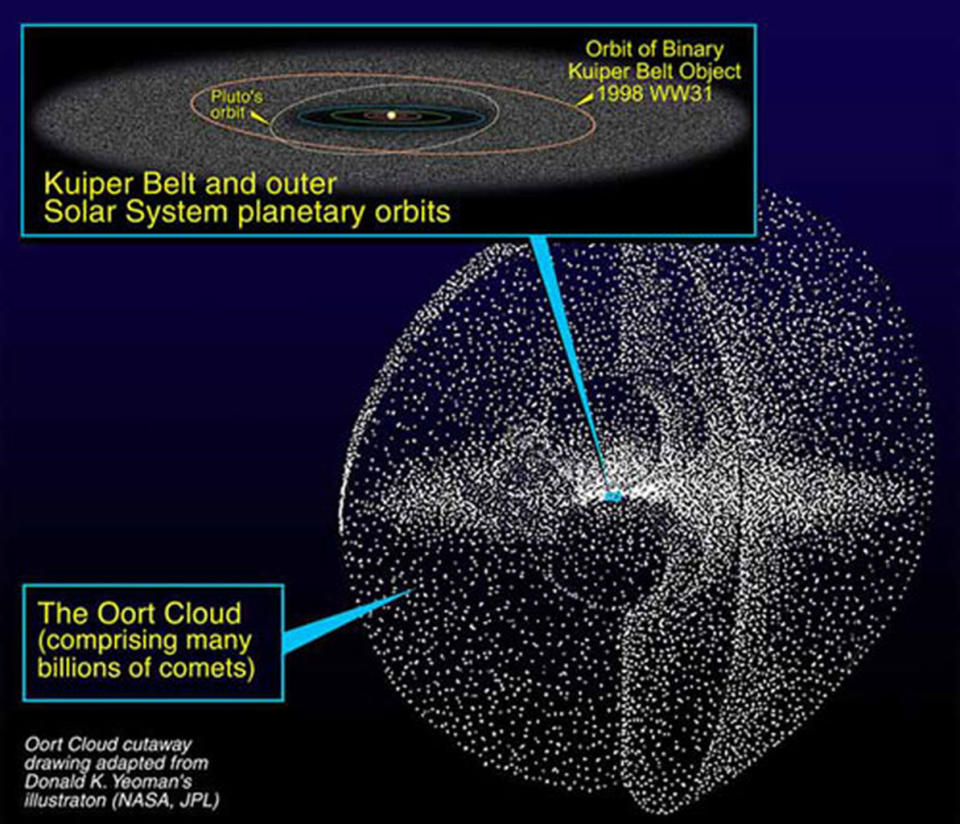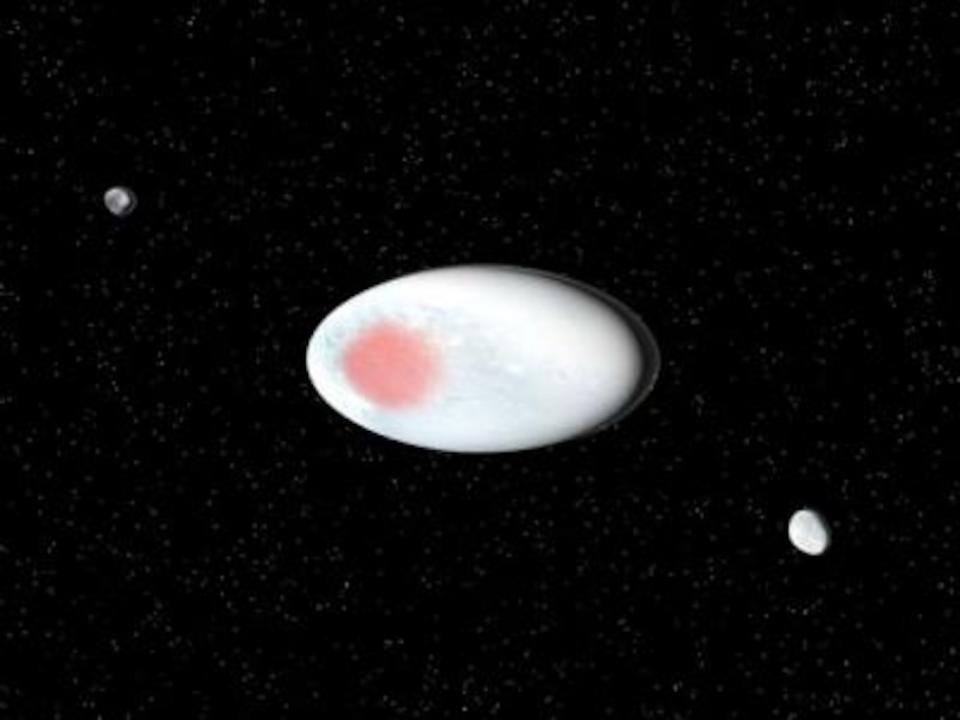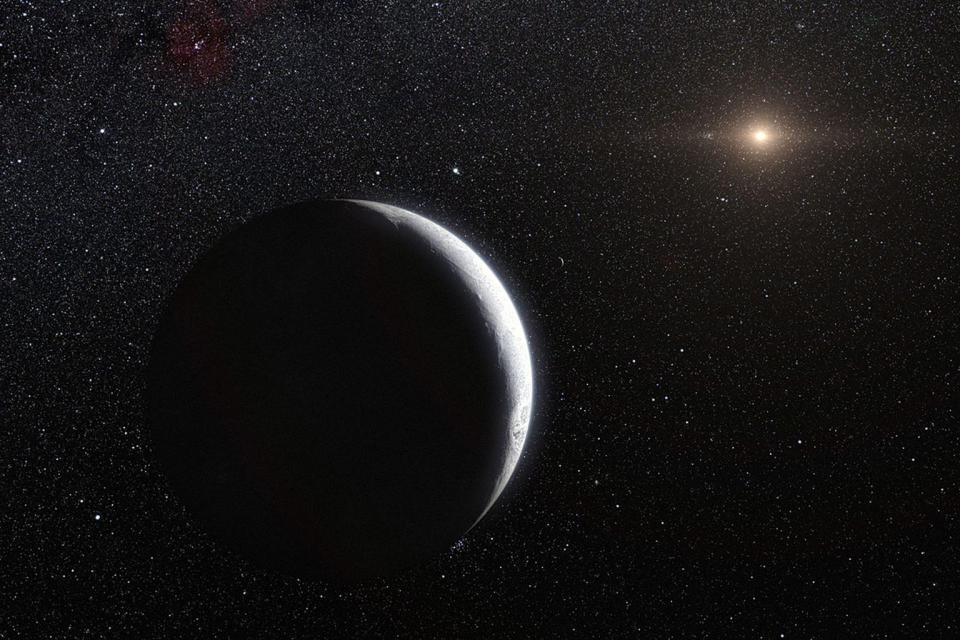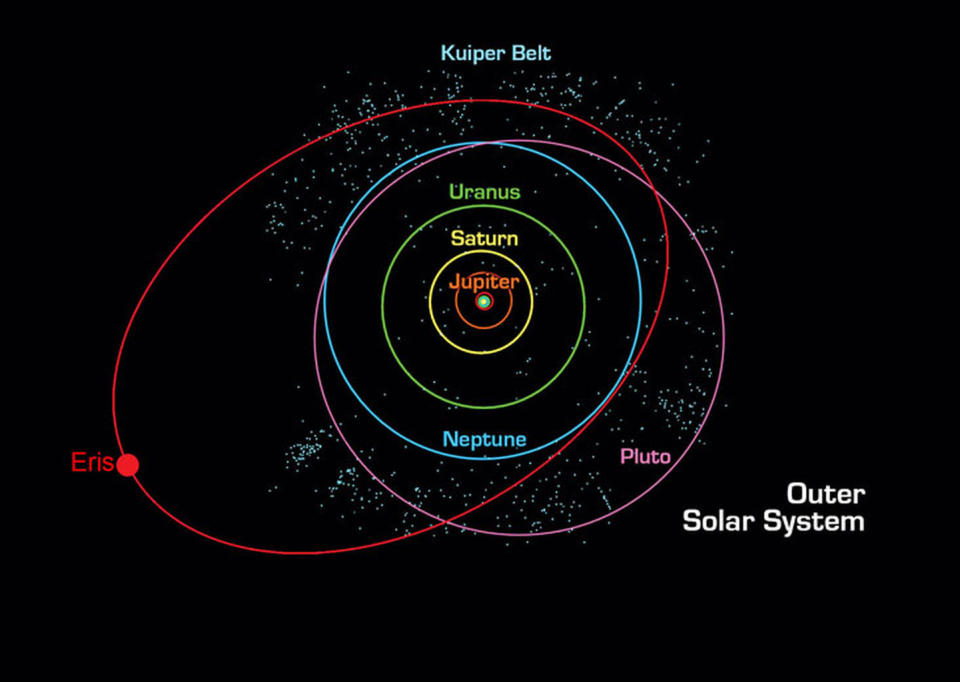Kuiper Belt Objects: Facts about the Kuiper Belt & KBOs
Beyond the gas giant Neptune lies a region of space filled with icy bodies. Known as the Kuiper Belt, this chilly expanse holds trillions of objects, remnants of the early solar system. Dutch astronomer Jan Oort first proposed in 1950 that some comets might come from the solar system's far suburbs. That reservoir later became known as the Oort Cloud. Earlier, in 1943, astronomer Kenneth Edgeworth had suggested comets and larger bodies might exist beyond Neptune. In 1951, astronomer Gerard Kuiperpredicted the existence of a belt of icy objects that now bears his name. Some astronomers refer to it as the Edgeworth-Kuiper Belt.
Astronomers are now hunting in the Kuiper Belt for a so-called "Planet Nine," a hypothetical world in the Kuiper Belt, after evidence of its existence was unveiled on Jan. 20, 2016. It is thought to be about 10 times the mass of Earth and 5,000 times the mass of Pluto.

Kuiper Belt facts

The Kuiper Belt is an elliptical plane in space spanning from 30 to 55 times Earth's distance from the sun, or 2.5 to 4.5 billion miles (4.5 to 7.4 billion kilometers). The belt is similar to the asteroid belt found between Mars and Jupiter, although the objects in the Kuiper Belt tend more to be icy rather than rocky.
Scientists estimate that thousands of bodies more than 100 km (62 miles) in diameter travel around the sun within this belt, along with trillions of smaller objects, many of which are short-period comets. The region also contains several dwarf planets — round worlds too large to be considered asteroids and yet not qualifying as planets because they're too small, on an odd orbit, and don't clear out the space around them the way the eight planets do.
Despite its massive size, the Kuiper Belt wasn't discovered until 1992 by Dave Jewitt and Jane Luu. According to NASA, the pair had been "doggedly scanning the heavens in search of dim objects beyond Neptune" since 1987. They dubbed the first object they spotted "Smiley" but it was later cataloged as "1992 QB1."
Kuiper Belt formation
When the solar system formed, much of the gas, dust and rocks pulled together to form the sun and planets. The planets then swept most of the remaining debris into the sun or out of the solar system. But bodies farther out remained safe from gravitational tugs of planets like Jupiter, and so managed to stay safe as they slowly orbited the sun. The Kuiper Belt and its compatriot, the more distant and spherical Oort Cloud, contain the leftover remnants from the beginning of the solar system and can provide valuable insights into its birth.
Under the Nice model, the Kuiper Belt may have formed closer to the sun, near where Neptune now orbits. In this model, the planets engaged in an elaborate dance, with Neptune and Uranus changing places and moving outward, away from the sun. They may have carried the Kuiper Belt objects with them, shepherding them ahead as they migrated.
The classical Kuiper Belt — the most crowded section — lies between 42 and 48 times Earth's distance from the sun. The orbit of objects in this region remain stable for the most part, although some objects occasionally have their course changed slightly when they drift too close to Neptune.
Kuiper Belt objects

Pluto was the first true Kuiper Belt object (KBO) to be seen, although scientists at the time didn't recognize it as such. The existence of the belt wasn't realized until Jewitt and Luu discovered a slow-moving, small world in the outer solar system. Other objects were soon discovered, and astronomers quickly saw that the region beyond Neptune teemed with icy rocks and tiny worlds.
Sedna, about three-fourths the size of Pluto, was discovered in 2004. It is so far out from the sun it takes about 10,500 years to make a single orbit. Sedna is about 1,100 miles (1,770 km) wide and circles the sun on an eccentric orbit that ranges between 8 billion miles (12.9 billion km) and 84 billion miles (135 billion km).
"The sun appears so small from that distance that you could completely block it out with the head of a pin," said Brown, who discovered this and several other Kuiper Belt objects.
In July 2005, astronomers announced the discovery of an object in the Kuiper Belt thought to be larger than Pluto, though subsequent observations revealed it was slightly smaller. Known as Eris, it orbits the sun approximately once every 580 years, traveling almost one hundred times farther from the sun than Earth does. Eris' discovery revealed to some astronomers the problem of terming Pluto a full-scale planet, and in 2006, Pluto, Eris, and the largest asteroid, Ceres, were reclassified as dwarf planets. Two more dwarf planets, Haumea and Makemake, were discovered in the Kuiper Belt in 2008.
But Haumea's status as a dwarf planet may be in doubt. In 2017, when the object passed between Earth and a bright star, scientists realized it is more elongated than round. Roundness is one of the criteria of a dwarf planet, according to the International Astronomical Union's definition. Haumea's fast spin may be responsible for its elongated shape; a day only lasts about four hours.
"I don't know if this will change the definition [of a dwarf planet]," Santos Sanz said. "I think probably yes, but probably it will take time."
The dwarf planet was already known to have moons, but Sanz and his team also found rings around it.
Planet Nine
Planet Nine is a hypothetical world thought to orbit the sun at a distance that is 20 times farther out than the orbit of Neptune. (The orbit of Neptune is 2.7 billion miles from the sun at its closest point.) The strange world's orbit is about 600 times farther from the sun than the Earth's orbit is from the star.
[The Evidence for 'Planet Nine' in Our Solar System (Gallery)]
Scientists have not actually seen Planet Nine directly. Its existence was inferred by its gravitational effects on other objects in the Kuiper Belt.
['Planet Nine': Facts About the Mysterious Solar System World (Infographic)]
Scientists Mike Brown and Konstantin Batygin at the California Institute of Technology in Pasadena described the evidence for Planet Nine in a study published in the Astronomical Journal. The research is based on mathematical models and computer simulations using observations of six other smaller Kuiper Belt Objects with orbits that aligned in a similar matter.
Exploration
Because of their small size and distant location, Kuiper Belt objects are a challenge to spot from Earth. Infrared measurements from NASA's space-based Spitzer telescope have helped to nail down sizes for the largest objects.
In order to catch a better glimpse of these remote leftovers from the birth of the solar system, NASA launched the New Horizons mission. The spacecraft reached Pluto in 2015 and continued on with an aim to examine multiple KBOs. On January 1, 2019 it will fly by the Kuiper Belt object 2014 MU69.
"2014 MU69 is a great choice because it is just the kind of ancient KBO, formed where it orbits now, that the Decadal Survey desired us to fly by," New Horizons principal investigator Alan Stern of the Southwest Research Institute (SwRI) in Boulder, Colorado, said in a statement.
Recent observations revealed that MU69 is elongated, and perhaps even a pair of Kuiper Belt objects together.
"This new finding is simply spectacular. The shape of MU69 is truly provocative, and could mean another first for New Horizons going to a binary object in the Kuiper Belt," Stern said.
New Horizons will continue to make history as it explores the Kuiper Belt.
"There's so much that we can learn from close-up spacecraft observations that we'll never learn from Earth, as the Pluto flyby demonstrated so spectacularly," said New Horizons science team member John Spencer, also of SwRI. "The detailed images and other data that New Horizons could obtain from a KBO flyby will revolutionize our understanding of the Kuiper Belt and KBOs."

Additional resources

